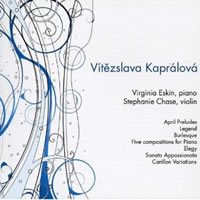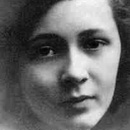
 The Music of Vítezslava Kaprálová
The Music of Vítezslava Kaprálová
Virginia Eskin, piano
Stephanie Chase, violin
Koch International Classics KICCD7742
As a composer, Kapralova also fits perfectly with Eskin's interests.
"I'm more interested, before I die, in making sure that the whole story of women in music is not something that people endlessly say 'Well, who are they?' and 'God, were they any good?' and 'Tell me their names again?'" Eskin exclaimed passionately. "I'm trying to build a fire under musicians and composers."
Virginia Eskin
The Music of Vítezslava Kaprálová
This comes as a very valuable addition to the select Kapralova discography. Tragically short-lived though she was, the Moravian composer left behind more than mere markers of potential greatness. There are important and thoroughly convincing things even in her least well-known works.
April Preludes found a champion in her fellow Moravian, Rudolf Firkusny. The four pieces, written in 1937, embrace late impressionist fanfares and driving drama with equal aplomb. The second Prelude is animated by powerful left hand figures and has a slightly crepuscular feel. The right hand meanwhile unleashes some unmistakably Czech folkloric cadences. There’s a wintry, brusque end to this prelude. The final one is pleasingly quasi-satiric.
The Legend for violin and piano is a resilient example of Franco-Delian inspiration whilst Burlesque, written at the same time and sharing an opus number, is a whimsical affair. I’ve not pursued the matter but perhaps these were the inner movements – andante and scherzo – from a projected violin sonata?
The earliest work here is the Op.1 Five Compositions for Piano, written in 1931-32. These contrast powerful, confident projection with correspondingly limpid simplicity. The Minuet is full of optimism whilst the last of the five has more than a hint of Je>ek’s lyric confidence about it.
 The “late” 1939 Elegy is a high-wire Szymanowskian balancing act, pushing the violin up high. Whereas the Sonata Appassionata is cut from different cloth. Written six years earlier it opens in a flurry of passion but has clearly absorbed much from the French school in its busy but unclotted clarity. The variations are brittle, sonorous, emphatic and graced with a perky fugato; the conclusion is suitably grand. It’s a work of veritable confidence.
The “late” 1939 Elegy is a high-wire Szymanowskian balancing act, pushing the violin up high. Whereas the Sonata Appassionata is cut from different cloth. Written six years earlier it opens in a flurry of passion but has clearly absorbed much from the French school in its busy but unclotted clarity. The variations are brittle, sonorous, emphatic and graced with a perky fugato; the conclusion is suitably grand. It’s a work of veritable confidence.
Talking of variations we also have the Variations sur le Carillon de l'Eglise Saint-Etienne-du-Mont a sparkling evocation replete with bell chimes, a touching but not somnolent chorale and an insouciant rather Gallic Allegro finale. Finally there’s Little Song for solo piano – which I was expecting to find post-Suk in its insinuating lyricism but which is actually rather perky.
The performances of this too-little known music are terrifically engaging. The notes by Karla Hartl are just right as well. Add this to your select discography of a composer whose early death deprived Czechoslovakia of a burgeoning talent.
Jonathan Woolf
www.musicweb-international.com
Contents
- April Preludes op. 13 (1937)
- Legend for violin and piano op. 3a (1932)
- Burlesque for violin and piano op. 3b (1932)
- Five Compositions for piano op. 1 (1931-2)
- Elegy for violin and piano (1939)
- Sonata Appassionata for solo piano op. 6 (1933)
- Variations sur le Carillon de l'Eglise Saint-Etienne-du-Mont op. 16 (1938)
- Little Song for solo piano (1936)
Opus Musicum (Opus Musicum Foundation in Brno)
by Dr. Jindra Bartova, Head of the Department of Music History; Faculty of Music, Janacek Academy of Performing Arts in Brno
"Obě zaslou m za nahravku dmla Kapralovi nejvym uznanm: dokonala technicka zroveň se na nm snoubm s hlubokm pro itkem a velkou imaginacm."
English translation: "Both of them deserve the highest praise for their performance in which impeccable technical skill is married to deeply sensitive and insightful imagination."
